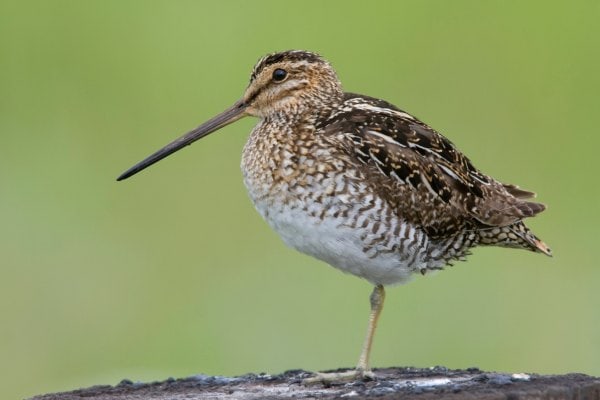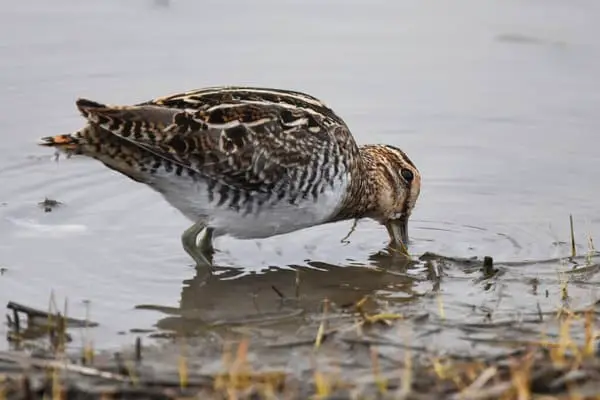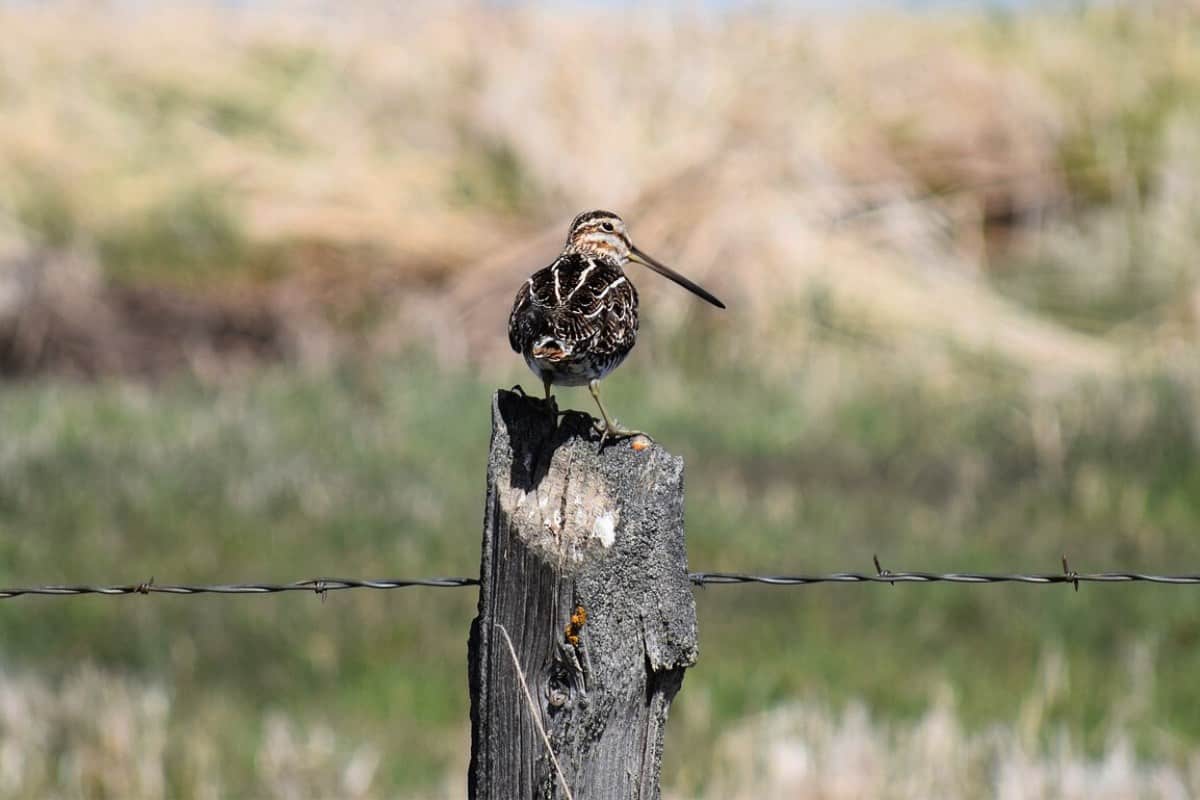Common Name: Wilson's Snipe
Scientific Name: (Gallinago delicata)| Size | Diet | Range in Hawaii | Status in Hawaii |
|---|---|---|---|
| 10 in. - 11 in. | earthworms, insects, and aquatic larvae | Kaua'i, O'ahu, Moloka'i, Maui, and Big Island | Least Concern |
The Wilson’s Snipe, also known as Gallinago delicata, is a medium-sized wading bird species that is native to North America. While the species is not native to Hawaii, it has been known to occasionally visit the islands as a non-breeding visitor and occasional winterer. With its unique appearance and distinctive behavior, the Wilson’s Snipe is a fascinating bird species that has captured the attention of birdwatchers and avian enthusiasts around the world.
In this article, we will explore the world of the Wilson’s Snipe, its unique characteristics, and its occasional presence in Hawaii.
Wilson’s Snipe
Appearance

The Wilson’s Snipe is a medium-sized bird, measuring about 10 to 11 inches (25 to 28 centimeters) in length. They sport cryptic, mottled brown and buff-colored plumage, ideal for blending into their marshy habitats. Their long, slender bills and distinctive stripes on their backs and heads make them an intriguing and well-adapted species.
Diet
Wilson’s Snipe are skilled foragers with a diverse diet. These birds primarily feast on a menu of small invertebrates, including earthworms, insects, and aquatic larvae. In addition to insects and worms, they may also munch on small crustaceans and plant matter found in their wetland habitats.
Nesting
Wilson’s Snipe are secretive nesters, adding an element of mystery to their breeding habits. These birds construct their nests on the ground, often hidden amidst the tall grasses and vegetation of their wetland habitats.
Their nests are simple yet cleverly designed, typically consisting of a shallow depression lined with grasses and leaves. The female snipe lays a clutch of eggs, usually containing four well-camouflaged eggs that blend seamlessly with their surroundings.
What’s particularly fascinating about Wilson’s Snipe nesting behavior is their parental dedication. Both male and female snipes take turns incubating the eggs, ensuring the safety and warmth of their developing young. This cooperative parenting approach highlights their commitment to successfully raising the next generation.
Behavior
One of their remarkable behaviors is their distinctive “winnowing” aerial display during the breeding season. Males climb high into the sky and produce a series of melodious, pulsating sounds by vibrating their outer tail feathers. This mesmerizing performance serves both as a territorial advertisement to attract females and a way to establish their dominance among rival males.
Wilson’s Snipe is also an exceptional forager. Equipped with long, sensitive bills, they use a “stitching” motion to probe the mud and soil for their favorite prey. Their skilled feeding techniques make them a vital component of wetland ecosystems.
Habitat

A Wilson’s Snipe has a strong affinity for wetland habitats, and their choice of homes is as intriguing as the birds themselves. These elusive waders can be found in a variety of marshy and watery environments throughout North America. Their preferred habitats include freshwater marshes, bogs, swamps, and the edges of ponds and lakes.
Range
Wilson’s Snipe are non-breeding visitors to Hawaii, primarily found in the Northwestern Hawaiian Islands, including Midway and Kure Atoll. While occasional sightings have occurred in the Southeastern Hawaiian Islands, like Kaua’i, O’ahu, Moloka’i, Maui, and Hawai’i Island, their presence is less common there due to limited suitable habitat. These winter visitors enrich the avian diversity of Hawaii’s Northwestern Islands, offering bird enthusiasts a unique sight.
Conservation Status

The Wilson’s Snipe (Gallinago delicata) is classified as a species of “Least Concern” by the International Union for Conservation of Nature (IUCN). This status suggests that the overall population of Wilson’s Snipe is not currently facing significant threats or declines.
Interesting Facts
1. Occasional confusion
These snipes can be challenging to identify, especially when compared to their Eurasian counterpart, the Common Snipe. Birdwatchers often need a keen eye and experience to differentiate between the two species accurately.
2. Nocturnal vocalization
Outside of the breeding season, Wilson’s Snipe is generally silent during the day. However, they become more vocal at night, with a series of sharp “chip” calls that can be heard in the darkness.
3. Courtship rituals
In addition to their aerial winnowing displays, male Wilson’s Snipe engages in ground displays during courtship. They strut, bob their heads, and perform elaborate dances to impress potential mates.
4. Leg color change
During the breeding season, the legs of Wilson’s Snipe change color, becoming a more vibrant orange-red. This change is believed to be related to courtship and signaling readiness to potential mates.
5. Hunting and sport
Historically, Wilson’s Snipe were popular game birds, and they are still legally hunted in some regions during the hunting season. Hunting regulations are enforced to ensure sustainable harvests.
Frequently Asked Questions
1. How can I differentiate between Wilson’s Snipe and Common Snipe?
Distinguishing between these two snipe species can be challenging. Wilson’s Snipe generally has a thicker and shorter bill, a bolder head pattern, and a white trailing edge on its wings, whereas Common Snipe tends to have a longer and thinner bill and a more subtle head pattern.
2. What is the lifespan of a Wilson’s Snipe in the wild?
Wilson’s Snipe can live for several years in the wild. Their lifespan depends on factors such as predation, habitat quality, and food availability.
3. Can I attract Wilson’s Snipe to my backyard or property?
Attracting Wilson’s Snipe to a specific location may be challenging because they have specific habitat requirements. If you have wetland or marshy areas on your property, you may naturally attract them by preserving these habitats.
4. Are Wilson’s Snipe protected by conservation laws?
The conservation status of Wilson’s Snipe varies by region and country. In some areas, they may be legally hunted during the hunting season, while in other regions, they may be protected. Regulations and protection status should be checked locally.
5. How can I contribute to the conservation of Wilson’s Snipe?
You can contribute to their conservation by supporting organizations that work to protect wetland habitats, volunteering for wetland restoration projects, and raising awareness about the importance of preserving these critical ecosystems.




